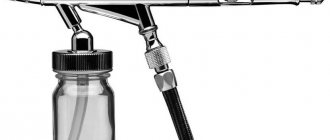DIY air swirler for the injector
In this article you will learn how to make an air swirler for an injector with your own hands.
All initial intermediate and final results were measured on a Holden VL Turbo accelerating from 0 to 100 km/h. The end result is a reduction in acceleration time to 100 km/h by 0.55 seconds. Costs are 30%; in Russia you can get by with 300 rubles. The article was written by a foreign tuning friend, for which we are grateful to him!
Let's start, the Holden VL Turbo tuning car has a 6-cylinder 3-liter engine with a turbine. The purpose of this tuning was to increase engine power at minimal cost and by refining the engine intake system. And also the opportunity to do tuning with your own hands .
To tune the air intake, it is quite enough to buy a zero-resistance filter, but the goal is slightly different and the end result should be more effective than from a zero-resistance filter. To measure pressure, a very simple but functional pressure gauge was made, the diagram of which is shown in the figure. The sensor must be connected in series to different points in the combustion chamber air supply system to obtain data on pressure reduction points.
Let's consider a simple diagram... if the pressure at the very end of the air supply system is greater than at the beginning, then the air flow cannot pass smoothly through some part of the system. The result is a deficiency of air in the combustion chamber, and at school we were taught that the more air, the faster and more voluminously the combustion process occurs, and this, in our case, increases engine power. Another important parameter is the temperature of the air supplied to the combustion chamber. The higher the temperature, the less dense the air, which means it contains less oxygen and, again, according to the previous scheme, the engine power decreases. As a result, you need to supply air as cool as possible to increase the amount of oxygen in it.
Stock Holden VL Turbo system
The air is supplied first to the intake pipe, then to the air filter box, then the oxygen sensor passes through the thoroughly cleaned filter and through the corrugation to the turbo compressor.
Testing
Now the task is to remove all places that interfere with direct air supply. Measurements with the assembled pressure gauge showed the following data:
The unit of measurement is the change in the liquid column in the vessel.
The air temperature was also measured using a digital temperature sensor. At the bottom of the air filter box the temperature is 30 degrees. But after some time it increased to 50, which is good and this is at an ambient temperature of 15 degrees.
And so the initial data:
Peak pressure: 29.5 Peak temperature: 50°C Acceleration 0-100 km/h: 8.0 sec
Finalization
1. Removing the 2nd from the 3rd coarse filter (from stones, leaves, etc.)
Result: reducing the total pressure in the system by 32% is not bad at all, without spending a penny.
If a zero-resistance filter on average gives only a 3% reduction in pressure, but you need to pay a tidy sum for it, and even service it every 3000 km. Acceleration from 0 to 100 km/h decreased to 7.7 seconds. 2. As a result of repeated measurements, the task of reducing resistance in the upper part of the air filter box was lost. We have 7 units of pressure at the bottom of the box. There was only one way out; a hole with a diameter of 100 mm was made in the lower part of the air filter box. a pipe of the same diameter is inserted, bent at 90 degrees and brought out into the wheel arch. The air intake was not brought into the front part of the car due to the risk of foreign objects getting in, especially since two of the three rough-cleaning partitions were removed. And by placing it in the arch, we get a good flow of air at speed and more or less good protection from dirt. The beginning of the air intake pipe was enlarged by heating and stretching with a conical object. Result: the pressure decreased from the initial 4 to 1 unit, and the air temperature decreased from 50°C to 20°C. Acceleration from 0 to 100 km/h decreased to 7.6 seconds. Costs 150 rubles per pipe.
3. Replacement of the corrugated pipe from the oxygen sensor to the turbine, loss of 4.5 units. It is in the corrugation that there are strong turbulences in the air flow, which is where the resistance increases by 26%. The price of a regular pipe of the same diameter is 150 rubles. Result: pressure decreased by 4 units. Acceleration from 0 to 100 km/h decreased to 7.45 seconds. The cost of a new pipe is also 150 rubles.
Summarizing:
Reduce resistance by half. Decrease in air temperature.
winning time of 0.55 seconds when accelerating from 0 to 100 km/h. The test readings on the bench increased equally in all sections of the curve, which means an increase at both low and high speeds, at minimal cost.
Source
Where to install
You can buy and install an additional air intake on any car. It is important to understand here that all cars already provide in advance the presence of inlet paths for the passage of air with its further entry into the engine and inside the engine to create an air-fuel mixture.
That’s why they put in purely auxiliary elements. They can be found on cars such as:
Some cars already have special windows with grilles on the hood, through which air enters for further passage into the heating system.
DIY air swirler for the injector
A swirler in the intake reduces CO levels and increases power. To make this “device” we will need: A textolite spacer for the carburetor. It is better to use the original one.
We will also need a gasket.
You can buy it on the market. It costs very little. If you don’t have the time or opportunity to purchase a gasket on the market, you can make it yourself. To do this, you need to cut it out of thick cardboard. You can use a textolite spacer as a template. We also need a compass.
It is advisable to purchase a compass with two needles at the end. We will also need a drill with a diameter of 0.5 mm, or a thicker drill, but its maximum limit is 0.8 mm. You will also need a 5 mm drill. 6 mm tap. Tap holder. Connector with 6 mm thread. Core drill. It is not necessary to purchase drill sets. One drill with a diameter of 44 mm is enough. They are sold individually. An ordinary wood drill, the cheapest. Here is a regular gasoline filter. The hose is ordinary with two clamps to connect the filter to the fitting. I ordered a thing from turners that fits tightly in the center of the spacer, in order to use a crown to cut a groove clearly at width=”400″ height=”234″[/img]
How to accurately drill a circle in the center.
If you don't have an insert, it can be easily replaced. Take a piece of wood and drill a hole in it with the same drill. When you have drilled holes in the board with a drill, place the plate on the board so that the drilled hole is in the center.
Holding the spacer well with your hand, guide the drill into this hole.
As a result, your cutter will stand the way you set it. Next we make two grooves. The depth can be made arbitrary, but it is not necessary to make it too deep, a couple of millimeters will be enough. Now you need to mark 6 holes on the plate, which will be at an equal distance from each other. Formula for their calculation:
41 x 3.14 / 6 = 21.45 mm, where 41 – Internal diameter of the circle (groove from the drill) 3.14 – Substitute value for the area of the circle 6 – Number of holes 21.45 – Distance between holes.
According to the diameter of our cutter, the distance turned out to be 21.5 mm. Taking this distance, and be sure to use a compass to once again make sure of the correct value so that everything matches.
air conditioner air intake
Tell me where the air intake of the air conditioner is located when you turn on the recirculation inside the cabin. I want to spray it with foam so it doesn't stink. I couldn’t find it in any topics on cleaning the evaporator or similar topics. Whoever shows me the photo, thank you very much. Ipsum 240 s 2003 has been rebuilt.
Ipsum ACM21 “I” Type S 2002
What kind of foam is this? The evaporator needs to be cleaned and the cabin filter changed. The fence from the passenger compartment is in front of the fan motor, under the glove compartment.
Posted by
Docktor777what does it smell like in there?
Usually it smells like mold











